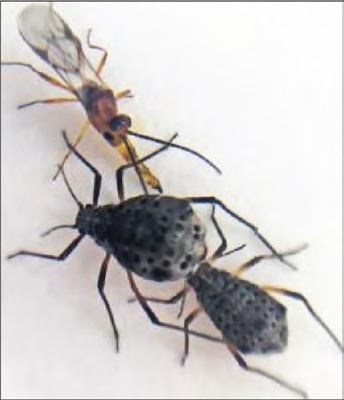PESTS AND DISEASES OF FORESTRY IN NEW ZEALAND
Giant Willow Aphid biocontrol update
Scion is the leading provider of forest-related knowledge in New Zealand
Formerly known as the Forest Research Institute, Scion has been a leader in research relating to forest health for over 50 years. The Rotorua-based Crown Research Institute continues to provide science that will protect all forests from damage caused by insect pests, pathogens and weeds. The information presented below arises from these research activities.
From Forest Health News 292, September 2019.
We have made great progress and achieved excellent results in our programme on the long-term management of the giant willow aphid (GWA), Tuberolachnus salignus, which has been causing widespread problems throughout New Zealand since it was first found here in 2013.
We have now completed host specificity trials and behavioural tests examining how our proposed biological control agent interacts with both GWA and other aphid species present in New Zealand. Based on the very favourable results, we have prepared an application to the Environmental Protection Authority for its release.
GWA impacts include damage to willows, unextractable honey due to bees feeding on GWA honeydew, increased pest vespid wasp populations (also honeydew feeders), and the growth of sooty mould on honeydew on fruit exports. The largest economic losses are caused by the damage to willows, resulting in lost erosion mitigation and carbon sequestration. The increase in pest vespid wasps is the second most costly issue, and has implications for apiculture, pollination services and human health, not to mention negative impacts on New Zealand’s biodiversity (pest wasps are known to predate on native insects and even bats, birds and lizards). The combined estimated economic impact of GWA in New Zealand is estimated at $300 million NZD per annum.
In 2016, we identified a promising biological control candidate for GWA: a Californian parasitoid wasp named Pauesia nigrovaria. This wasp is a highly specific natural enemy of GWA in its native environment, and in December 2017 we successfully bought some of these parasitoids into our containment facility at Scion in Rotorua.

In the following eighteen months we undertook host testing trials of P. nigrovaria against five non-target aphid species, representing a range of aphid groups present in New Zealand.
The cypress aphid, Cinara fresai (Lachninae) was chosen as it is in the same subfamily as GWA and comes closest to it in body size. The black peach aphid Brachycaudus persicae (Aphidinae: Macrosiphini) represents the largest group of aphids in New Zealand, and the three-remaining species represent New Zealand's three native aphid lineages: the Muehlenbeckia aphid Aphis cottieri (Aphidinae: Aphidini), the tōtara aphid Neophyllaphis totarae (Neophyllaphinae) and the southern beech aphid Sensoriaphis nothofagi (Taiwanaphidinae).
Results of the host testing trials were excellent for all non-target aphid species, with zero parasitism recorded on any species other than the target, GWA. In addition to these trials, we also conducted behavioural assessments with P. nigrovaria and three aphid species: GWA, the closely-related cypress aphid and the black peach aphid.
These assessments showed that P. nigrovaria paid little attention to the non-target species, compared to GWA. Antennal and ovipositor contact on the non-target species were significantly less, though one female wasp did appear to oviposit in two cypress aphids. However, no progeny developed, and subsequent dissections revealed no evidence of an egg or a larva. Pauesia nigrovaria made no attempt to oviposit in the less closely-related black peach aphid.
With both the host testing results and behavioural assessments indicating very little or no risk to non-target species, we believe that P. nigrovaria is safe to release in New Zealand, and that its introduction will be beneficial, leading to a reduction in the damaging effects of giant willow aphids and the problems associated with their feeding activities. These include increased health of trees used for erosion control, improved health of honeybees and honey quality, reductions in harmful sooty mould, and reduced populations of invasive pest insects such as vespid wasps and harlequin ladybirds, both of which are voracious predators of native and beneficial insects.
Applying to the Environmental Protection Authority to release P. nigrovaria is an in-depth process and we are seeking public participation to support our proposal. You can make an online submission at www.epa.govt.nz/public-consultations, or send a letter of support to us at Scion. If approved, we expect the first releases of P. nigrovaria to occur in early 2020.
This information is intended for general interest only. It is not intended to be a substitute for specific specialist advice on any matter and should not be relied on for that purpose. Scion will not be liable for any direct, indirect, incidental, special, consequential or exemplary damages, loss of profits, or any other intangible losses that result from using the information provided on this site.
(Scion is the trading name of the New Zealand Forest Research Institute Limited.)



